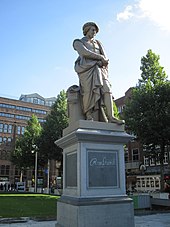Rembrandtplein
[1][2] By the early twentieth century, the square developed into a centre for nightlife drawing artists, young people and laborers.
The largest building on the square, across Utrechtsestraat, was designed in 1926 by architects Bert Johan Ouëndag and Hendrik Petrus Berlage as the head office of the Amsterdamsche Bank, later ABN AMRO.
[4] ABN AMRO vacated the structure in 2002 and in 2011 it reopened as retail office building named simply The Bank with 25,000 m2 (270,000 sq ft) of space after a five-year renovation.
Tram lines 4, 9 and 14 operate on Regulierbreestraat and connect Rembrandtplein to the Stopera, northwest across the Blauwbrug (Blue Bridge) on the Amstel River, Dam Square to the northeast, and Amsterdam Centraal railway station.
It occupies a space in the centre of the square facing a plaza paved with matching gray granite slabs accented by planters, trees and a small fountain.
Rembrandtplein business association was unable to reach an agreement with the artists (Mikhail Dronov and Alexander Taratynov) [11] regarding either the rental or purchase of the Night Watch sculptures.

